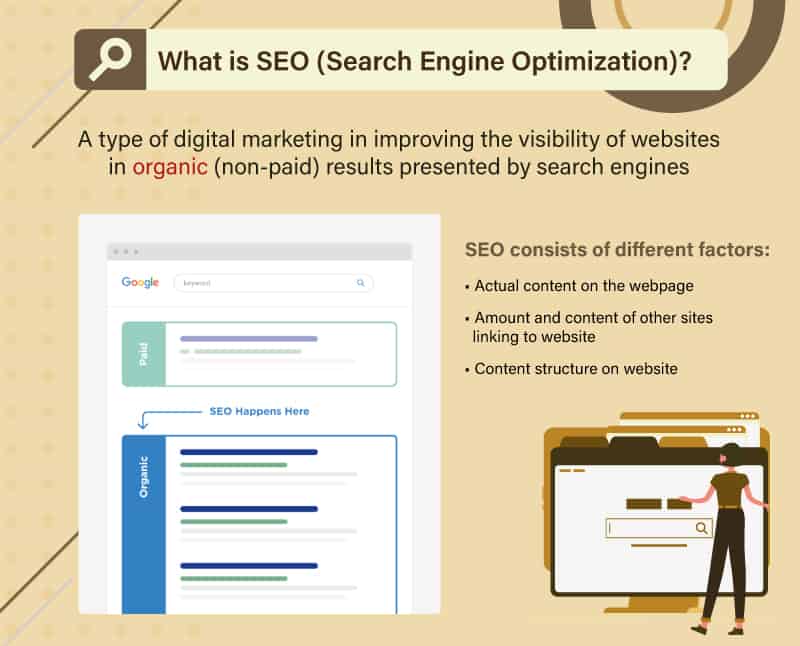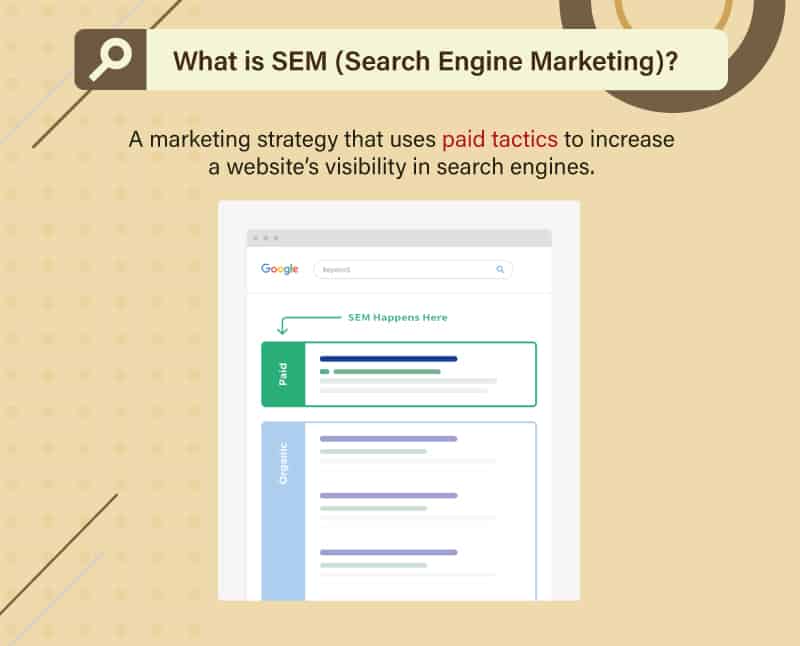
For the organization that aim to attract attention, generate website traffic, and build their business, search optimization is a must-have marketing approach. Search engines aid in the development of brand trust and credibility. When a large number of websites connect to the content on your webpages, search engines recognize that your site is trustworthy and credible, which boosts your search ranks.
SEO and SEM tactics may sound similar, but they are two different approaches to search optimization. If you confuse the words SEM and SEO and don’t understand the differences, you won’t be able to express clear and effective tactics to boost your search presence.

Search Engine Optimization (SEO) is a type of digital marketing focused on improving the visibility of webpages or entire websites in organic (non-paid) results presented by search engines to various queries. SEO focuses on the technical and design aspects of enhancing web rankings to increase search engine awareness and organic visitor traffic. SEO consists of a number of different factors, including the actual content on your web page, the amount and content of other sites linking to your site, and even the content structure on your site.

Search Engine Marketing (SEM) is a marketing strategy that uses paid tactics to increase a website’s visibility in search engines. A paid SEM strategy includes both the activities involved with setting up and optimizing ads as well as setting a budget that pays for the placement of ads.

SEO is a type of SEM, but now most people tend to treat SEO and SEM independently. Here, we discuss about the importance of SEM and SEO in the actual business scenarios of the enterprise. As we know that, SEM and SEO complement each other. All the opinion saying that SEM is better or SEO is better is not correct.
Below is the differences between SEM and SEO from several aspects:
- The most noticeable distinction is the time of investment required. Some people believe that SEO is completely free, however this is not the case. Creating a page that ranks at the top of search results involves time, effort, and money. It’s essentially a one-time investment that pays out in the long run. If you utilize SEM, on the other hand, you will have to pay for each click your ad receives.
- Each strategy requires a particular type of content. The foundation of SEO is the creation of high-quality content, which is generally in a longer format. SEM advertising, on the other hand, have a limited number of characters and landing sites for optimum effect.
- On SERPs, search results generated from SEM or SEO appear differently. A paid ad that appears as a result of SEM methods is frequently characterized as an ad, for example, by a sign that displays next to the placement, whereas search results that emerge as a consequence of organic SEO do not.
- Traffic accuracy between SEO and SEM.SEO mainly adjusts and optimizes the website according to the needs of users and Google algorithm, so that the website is more in line with the recommendation mechanism of search engines. It can better meet the needs of users, which is more popular with users, and naturally improves the search ranking. On the contrary, SEM is a form of paid traffic. Compared with SEO, it is not good enough. The traffic it brings is not accurate enough and the bounce rate is relatively high.
- SEO has a greater click-through rate (CTR) than SEM. CTRs are often highest in the first few organic search results. As a result, if you can go to the top, you’ll almost certainly outperform SEM advertisements. However, if you appear on the second page of results or lower, SEM is likely to generate you more clicks.

For different types of businesses, SEO and SEM are distinct. If you’re launching a new website and want to drive targeted traffic while you work on your organic SEO strategy, a SEM approach that gets you on the first page of search results is a good idea. Ranking for some terms can take years, which is why you should consider implementing a paid campaign to enhance website traffic and brand exposure.
The search optimization strategy you select will also be determined by your budget. SEO is less expensive and helps you plan for the future, whereas SEM is more costly but provides quick results. PPC-enabled websites receive instant traffic, but the traffic will disappear once the paid activity ceases. Those who utilize organic SEO strategies benefit from free website traffic as well as other industry-recognized benefits. However, it takes time.
From research, most experts advise using both strategies for search marketing. Use SEO as a foundation for growth and SEM to boost your ranking. In 2020, the combination of organic (40%) and paid search (28%) is still as powerful as ever, with 68% of all trackable website traffic coming from a combination of the two strategies. This implies that they are both more beneficial for websites than other traffics. These techniques can be combined to fulfil your short and long-term marketing objectives, allowing you to reach more prospects and increase brand awareness. Concentrating on both will also put you ahead of competitors who just focus on one.

For the organization that aim to attract attention, generate website traffic, and build their business, search optimization is a must-have marketing approach. Search engines aid in the development of brand trust and credibility. When a large number of websites connect to the content on your webpages, search engines recognize that your site is trustworthy and credible, which boosts your search ranks.
SEO and SEM tactics may sound similar, but they are two different approaches to search optimization. If you confuse the words SEM and SEO and don’t understand the differences, you won’t be able to express clear and effective tactics to boost your search presence.

Search Engine Optimization (SEO) is a type of digital marketing focused on improving the visibility of webpages or entire websites in organic (non-paid) results presented by search engines to various queries. SEO focuses on the technical and design aspects of enhancing web rankings to increase search engine awareness and organic visitor traffic. SEO consists of a number of different factors, including the actual content on your web page, the amount and content of other sites linking to your site, and even the content structure on your site.

Search Engine Marketing (SEM) is a marketing strategy that uses paid tactics to increase a website’s visibility in search engines. A paid SEM strategy includes both the activities involved with setting up and optimizing ads as well as setting a budget that pays for the placement of ads.

SEO is a type of SEM, but now most people tend to treat SEO and SEM independently. Here, we discuss about the importance of SEM and SEO in the actual business scenarios of the enterprise. As we know that, SEM and SEO complement each other. All the opinion saying that SEM is better or SEO is better is not correct.
Below is the differences between SEM and SEO from several aspects:
- The most noticeable distinction is the time of investment required. Some people believe that SEO is completely free, however this is not the case. Creating a page that ranks at the top of search results involves time, effort, and money. It’s essentially a one-time investment that pays out in the long run. If you utilize SEM, on the other hand, you will have to pay for each click your ad receives.
- Each strategy requires a particular type of content. The foundation of SEO is the creation of high-quality content, which is generally in a longer format. SEM advertising, on the other hand, have a limited number of characters and landing sites for optimum effect.
- On SERPs, search results generated from SEM or SEO appear differently. A paid ad that appears as a result of SEM methods is frequently characterized as an ad, for example, by a sign that displays next to the placement, whereas search results that emerge as a consequence of organic SEO do not.
- Traffic accuracy between SEO and SEM. SEO mainly adjusts and optimizes the website according to the needs of users and Google algorithm, so that the website is more in line with the recommendation mechanism of search engines. It can better meet the needs of users, which is more popular with users, and naturally improves the search ranking. On the contrary, SEM is a form of paid traffic. Compared with SEO, it is not good enough. The traffic it brings is not accurate enough and the bounce rate is relatively high.
- SEO has a greater click-through rate (CTR) than SEM. CTRs are often highest in the first few organic search results. As a result, if you can go to the top, you’ll almost certainly outperform SEM advertisements. However, if you appear on the second page of results or lower, SEM is likely to generate you more clicks.

For different types of businesses, SEO and SEM are distinct. If you’re launching a new website and want to drive targeted traffic while you work on your organic SEO strategy, a SEM approach that gets you on the first page of search results is a good idea. Ranking for some terms can take years, which is why you should consider implementing a paid campaign to enhance website traffic and brand exposure.
The search optimization strategy you select will also be determined by your budget. SEO is less expensive and helps you plan for the future, whereas SEM is more costly but provides quick results. PPC-enabled websites receive instant traffic, but the traffic will disappear once the paid activity ceases. Those who utilize organic SEO strategies benefit from free website traffic as well as other industry-recognized benefits. However, it takes time.
From research, most experts advise using both strategies for search marketing. Use SEO as a foundation for growth and SEM to boost your ranking. In 2020, the combination of organic (40%) and paid search (28%) is still as powerful as ever, with 68% of all trackable website traffic coming from a combination of the two strategies. This implies that they are both more beneficial for websites than other traffics. These techniques can be combined to fulfil your short and long-term marketing objectives, allowing you to reach more prospects and increase brand awareness. Concentrating on both will also put you ahead of competitors who just focus on one.




1 comment